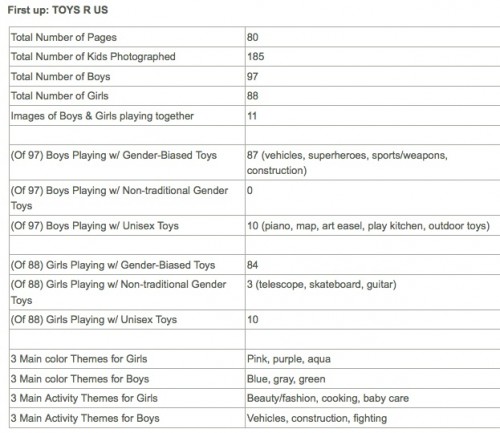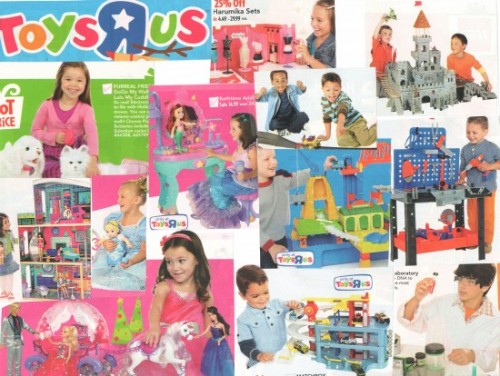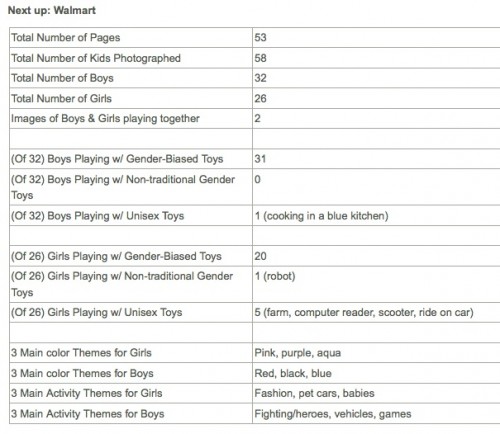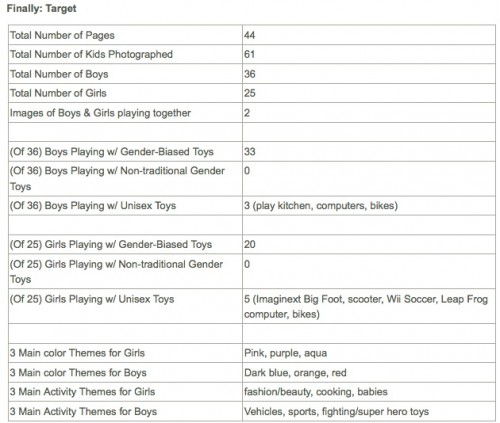Jessica B. sent in a link to a really great post over at Pigtail Pals. The author, Melissa, analyzed the contents of a number of holiday-season catalogs advertising toys. She tabulated how many girls and boys appear in each, how many are shown doing gender-stereotypical vs. non-stereotypical activities, and the main themes of the toys.
Here are the results for Toys ‘R’ Us:
Images from the catalog:
Wal-Mart:
Target:
It’s particularly striking to me how few images there are of girls and boys playing together, a predictable outcome, I suppose, of our insistence that boys and girls need different toys — since, if must play with different toys, they won’t be playing together.
Melissa discusses the specific images on several pages of the catalogs — check her full post out for more commentary.





Comments 21
TeaHag — December 23, 2010
Interesting, but why is a piano a unisex toy but a guitar a non-gender toy (referring to the description of the Toys R Us catalogue)?
MK — December 23, 2010
I'm confused about the gendered/non-gendered toy distinction here. Any reason that play kitchens are classed as "unisex"? "Vehicles" are gendered male but "ride on car" is "unisex"?
I'm also curious to know how many photos depict children playing together in single-sex groupings? It would help to interpret the "images of boys & girls playing together" category - it looks like the majority of the photos just show a single child.
jake — December 23, 2010
And... traditionally isn't a play kitchen considered a gender biased item with girls in mind?
Anonymous — December 23, 2010
I'm going to echo these voices that I find the categorization suspect to the point where it almost seems no thought went into it. A guitar is a boys' toy? A kitchen and scooter are unisex? And what does "outdoor toys" even mean? There are many cases where I would imagine that "outdoor toys" fit more into the boys' category than unisex, like sporty things or waterguns, for instance.
Not that I think all this categorization is realistic, of course, but really, if we're talking stereotypes, we might as well get the stereotype right if we can draw any meaningful conclusion.
Claire — December 23, 2010
I would like to point out that in all of the featured catalogues there are more boys pictured than girls. Evidence of a gender bias?
Andrew — December 23, 2010
"It’s particularly striking to me how few images there are of girls and boys playing together, a predictable outcome, I suppose, of our insistence that boys and girls need different toys — since, if must play with different toys, they won’t be playing together."
The more kids share toys, the fewer toys get sold. Gendering toys and optimizing them for individual play are both great ways of nudging families toward buying more different items per child.
When corporations promote ideas and images that *don't* enhance profitability, that's when the red flag should be raised on the other agendas.
Syd — December 23, 2010
I'm going to join in the chorus that some of Melissa's classifications of what is 'unisex/gender neutral,' 'feminine,' and 'masculine' seems entirely arbitrary, and while some of those things are pretty set in our society (ex; dolls are for girls) others seem to be entirely dependent on a person's upbringing, regional norms, and the context the toy itself is in. Indeed, why is one instrument unisex but another is masculine? I feel like it's been at least a decade since 'girls playing guitars' has been even remotely deviant from gender norms; girls-rocking-out has been a popular trope for incredibly gendered toys (Barbies, Bratz, Ponies, etc) since I was in grade school, and I always thought the 'girl playing bass' was actually a stereotype in mixed gender bands. The telescope also confuses me; while there is no doubt a male dominance in science in general, that drastic gender divide is NOT nearly as present in astronomy as it is in other science and math fields (I've also noticed it to be more racially inclusive than other sciences, but that's another story). Why is a kitchen feminine if it is pink, but unisex if it's blue? Why is a Barbie ride-on car unisex; does the fact that it is pink (girly!) but it is a vehicle (boyish!) cancel out any gender implications? Why is that ball masculine; it's rainbow colored and doesn't seem to have much of a function aside from looking pretty. It's a very interesting article, but it really has no apparent method to it aside from Melissa's initial reaction, so in some cases, it seems pretty meaningless.
I also think it's disturbing that she says the girl playing the guitar has her hair 'messed up' (even if she does paint that as a good thing); the girl's hair is not messed up, it is in motion because she's apparently jumping in the air. This is especially jarring because she mentions racial stereotypes early on in her article, but then immediately acts as if there is something terribly unusual and 'messy' with a black child's hair not being totally motionless. I also think her thoughts on the proportion of dolls were totally out of place in the article; someone needs a lesson in Uncanny Valley. Compare a generic Barbie doll or a doll made to imitate a cartoon (like the Disney Princess dolls shown) to dolls that try to imitate real human beings (easiest example to find would be Twilight promotional dolls made to look like Robert Pattinson and Kristen Stewart, or dolls made to look like teen stars such as Miley Cyrus or the Olsen twins). Barbie and Cinderella are not realistic, but they are popular and lovable because of their unrealistic generic cuteness; they look kind of like people, but their idealized form always reminds you 'this is not a person, this is a toy.' But dolls based on famous people are rarely popular among their target audience (aside from the Twilight dolls, I assume, if only because they continue to be in stores; I don't know anyone who owns one), and they are unpopular for a reason; they are quite a bit more realistic in proportion, but the fact remains that they will never be real, because they are made of plastic. Those dolls are almost always VERY ugly, even if the person they are supposed to look like is quite attractive. They are not just unattractive to look at, though; they are, for a large portion of the population, downright TERRIFYING. Dolls SHOULD NOT have accurate human proportions because they are not humans. The complaint about 'Barbie would have to crawl on her hands and knees' (which, BTW, is totally false; she'd just be really icky looking) is a totally irrational response to dolls, and just an excuse to ignore the real sources of bad self-esteem among young girls for an easy scapegoat.
Inspiring blog: Sociological Images | W-Women Globally — January 1, 2011
[...] Gender in Toy Catalogues – an analysis of contents of a number of holiday-season catalogs advertising toys in US. [...]
Ben — January 16, 2011
There's the obvious and expected here. The less glaring instance, but far more interesting is in the rare cases of gender flexibility, it is seen for girls only. No boys crossover to the "non-traditional gender toys", but girls do crossover. Girls are more likely to use unisex toys. Gender flexibility is rare, but available to girls, but not to boys.
Constructed Meanings — February 20, 2011
[...] Equally interesting are the sizes of the fonts. All the phrases are repeated in different sizes, however the ones most prominently displayed in larger fonts include “Thanks for always giving me Hell” and “Actions speak louder than words” where as the smaller font phrases include “Thanks for always being there”. The positive, vulnerable sentiments seem minimized (literally and figuratively) whereas the “tough skin” sentiments and discouragement of verbal communication are emphasized. If this were one ad, isolated and rare we could dismiss these meanings but taken into the larger context of American social life, they seem to echo masculine ideals we see and hear all the time. They are part of the bigger, more complex and interlocking conception of masculinity as that of actors (not talkers). (Sociological Images has discussed this numerous times, one example being: Gendering Toys) [...]
Thistle — March 25, 2012
This is an old post but I just found this site. Looking at the analysis, I find the whole thing suspect. Why is a telescope classified as a girl playing with a non-traditional gendered toy but a boy playing with a kitchen is unisex? Like it or not, I think kitchens are FAR more associated with female gender than telescopes are for male. While I am regularly appalled at the gender stereotypes implicit in children's toy advertising, I think this analysis is poorly done and structured to generate a certain outcome.